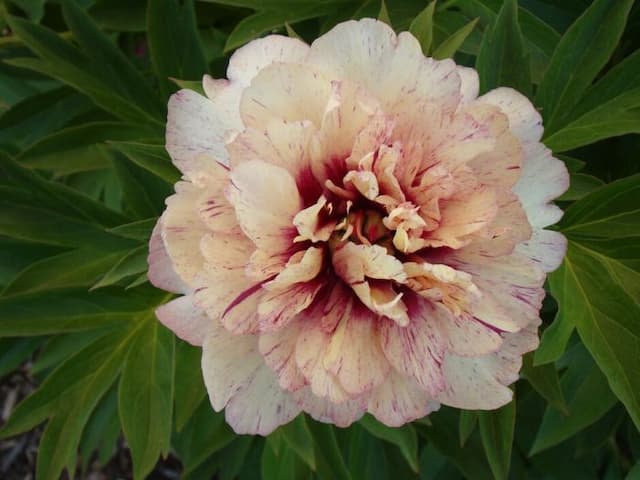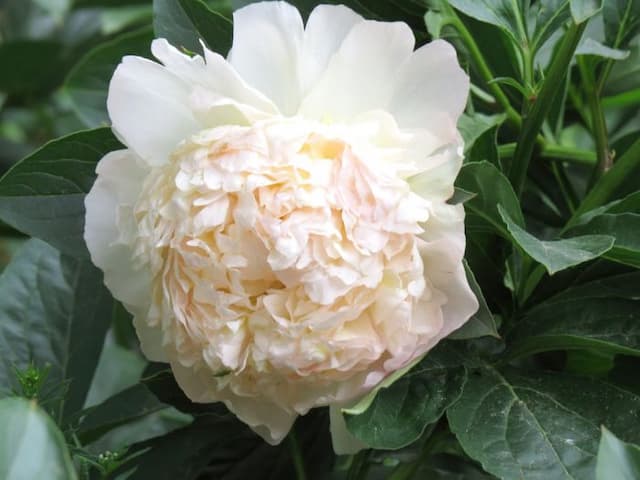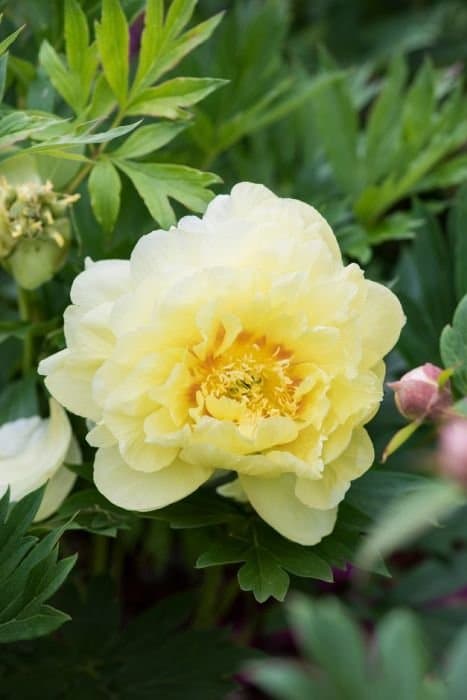Red Sarah Bernhardt Peony Paeonia lactiflora Red Sarah Bernhardt
![peony [Red Sarah Bernhardt]](/_next/image?url=https%3A%2F%2Fplants-admin.emdemapps.com%2Fimages%2Fplants%2F%2Fimages%2F604b5369d170e.png&w=3840&q=75)
ABOUT
The Red Sarah Bernhardt peony is a stunning perennial plant known for its captivating double blossoms. These flowers are particularly striking with their rich, deep pink to red hues that draw the eye. Each bloom is plush and full, with numerous ruffled petals layered to create a dense, spherical form that is both lush and romantic. The flowers are carried on strong stems that rise above the plant's deep green foliage. This foliage is divided into leaflets that are broad and have a glossy, leathery texture. The contrast between the dark foliage and the bright blossoms make this variety of peony a standout in any garden display. The plant is also valued for its fragrant flowers, which are known to emit a pleasant, sweet scent that can fill the surrounding air. The Red Sarah Bernhardt peony brings a classic elegance to garden landscapes and makes an excellent cut flower for arrangements, owing to its striking appearance and delightful fragrance.
About this plant
 Names
NamesFamily
Paeoniaceae
Synonyms
Red Sarah Bernhardt Peony, Chinese Peony, White Peony
Common names
Paeonia lactiflora Pall., Paeonia edulis Salisb.
 Toxicity
ToxicityTo humans
Peonies, like the Paeonia lactiflora Red Sarah Bernhardt, are not considered highly toxic to humans. However, they can cause mild discomfort if ingested. Eating parts of the plant can cause nausea, diarrhea, and vomiting. The symptoms are usually not severe, but it is still advisable to avoid ingesting any part of the peony plant. Handling the plant can also cause skin irritation in some people.
To pets
Peonies, including the Paeonia lactiflora Red Sarah Bernhardt, are considered toxic to pets such as dogs and cats. If a pet ingests any part of a peony, they can exhibit symptoms of poisoning which may include vomiting, diarrhea, and drooling. In severe cases, ingestion can lead to depression or anorexia. It's important to seek veterinary attention if you suspect your pet has ingested peonies or is showing signs of poisoning.
 Characteristics
CharacteristicsLife cycle
Perennials
Foliage type
Deciduous
Color of leaves
Green
Flower color
Pink
Height
2-3 feet (0.6-0.9 meters)
Spread
2-3 feet (0.6-0.9 meters)
Plant type
Herbaceous
Hardiness zones
3-8
Native area
China
Benefits
 General Benefits
General Benefits- Aesthetic Appeal: Peony Red Sarah Bernhardt adds vibrant color and full, lush blooms to gardens, which can enhance the overall beauty of the landscape.
- Attracts Pollinators: This variety of peony attracts bees and butterflies, contributing to pollination of plants and the health of the local ecosystem.
- Longevity: Peonies are known for their longevity, being able to thrive and bloom for decades with proper care.
- Low Maintenance: Once established, peonies require minimal care beyond the occasional watering during dry periods and removal of spent flowers.
- Seasonal Interest: Peonies have a specific blooming season in late spring to early summer, offering a seasonal display that many gardeners look forward to.
- Cut Flowers: The full, fragrant blooms make excellent cut flowers for vases and arrangements, with a long vase life compared to many other flowers.
- Tolerant to Many Soils: Peonies are adaptable to a range of soil types, although they prefer well-drained, fertile soil.
- Cold Hardy: This plant is suitable for growing in regions with colder climates, as it can withstand winter temperatures, going dormant and returning each spring.
- Herbaceous Perennial: As a herbaceous perennial, the plant dies back to the ground each fall and re-emerges from its root system in the spring, offering an interesting lifecycle dynamic to observe in the garden.
 Medical Properties
Medical Properties- Anti-inflammatory: Paeonia lactiflora has compounds that may help reduce inflammation.
- Analgesic: It may have pain-relieving capabilities.
- Immunomodulatory: The plant may have effects on the immune system.
- Antispasmodic: It may ease muscle cramps and spasms.
 Air-purifying Qualities
Air-purifying QualitiesThis plant is not specifically known for air purifying qualities.
 Other Uses
Other Uses- As a fabric dye – The petals of the peony can be used to create natural dyes for fabric, imparting a soft pink to purplish hue, depending on the mordant used.
- Art and illustration – Illustrators and botanical artists often use peonies like Red Sarah Bernhardt for inspiration, capturing their lush, full blooms in detailed drawings and paintings.
- Culinary garnish – The petals of peonies can be used as edible garnishes on desserts and salads, adding a touch of elegance to the presentation of a dish.
- Photography – Peonies are a popular subject for photographers due to their large, impressive blooms and the depth they add to floral compositions.
- Wedding decor – Peonies, known for their romantic appearance, are often incorporated into bridal bouquets, centerpieces, and venue decorations for weddings.
- Craft materials – Dried peony petals can be used in crafting, such as in homemade soaps, candles, or potpourri.
- Perfumery – While not a direct use of the plant itself, the Red Sarah Bernhardt peony's scent can inspire perfumes and other fragranced products.
- Eco-friendly confetti – Dried peony petals can serve as a biodegradable alternative to traditional paper or plastic confetti at celebrations.
- Floral water – The petals can be steeped in water to create a delicately scented floral water for room freshening or linen sprays.
- Cultural symbolism – Peonies like the Red Sarah Bernhardt are rich in cultural symbolism, particularly in China and Japan, and are used during festivals and in artwork to represent honor, wealth, and beauty.
Interesting Facts
 Feng Shui
Feng ShuiThe Peony is commonly used in Feng Shui to attract love and romance, so you could place the Peony in the southwest corner of your garden or home to enhance these aspects of your life.
 Zodiac Sign Compitability
Zodiac Sign CompitabilityThe Peony is not used in astrology practice.
 Plant Symbolism
Plant Symbolism- Prosperity: The robust and lush blooms of the peony, including the Red Sarah Bernhardt variety, often symbolize wealth and prosperity due to their full, rounded shape.
- Romance: With its deep red hue, the Red Sarah Bernhardt peony is associated with passion and romantic love, making it a popular choice for romantic occasions and gestures.
- Good Fortune: In many cultures, peonies are believed to bring good luck and good fortune, particularly in the realm of marriage and relationships.
- Beauty: Peonies are often admired for their beauty and the Red Sarah Bernhardt peony, with its striking red petals, symbolizes the idea of breathtaking beauty in bloom.
- Honor: The peony is seen as a flower of honor and high esteem, often used in ceremonies or given as a token of respect.
- Compassion: Peonies can also represent compassion and empathy, conveying a sense of concern and understanding for others.
 Water
WaterPeonies, including the Red Sarah Bernhardt variety, typically require watering once a week during the growing season, ensuring the soil is moist but not waterlogged. Apply about one inch of water, which is roughly equivalent to 0.6 gallons for a new plant and up to 2 gallons for an established bush. Water at the base of the plant to avoid wetting the foliage, which can lead to fungal diseases. During extended periods of drought, you may need to water twice a week. Cut back on watering as the plant goes dormant in fall.
 Light
LightPeonies, like the Red Sarah Bernhardt, thrive in full sun to partial shade. They need at least six hours of sunlight each day to bloom properly. Planting Red Sarah Bernhardt peonies in a spot that receives morning sun and afternoon shade can help protect the blooms from the intense heat of the day.
 Temperature
TemperatureThe Red Sarah Bernhardt peony is hardy and can tolerate a wide range of temperatures but performs best when the daytime temperature is between 65°F and 75°F. They are cold hardy down to about -20°F in the winter and can withstand up to 85°F to 90°F in the summer without significant stress.
 Pruning
PruningPrune Red Sarah Bernhardt peonies in fall after the foliage turns brown to remove any dead or diseased stems and leaves. This prevents overwintering diseases and pests. Cut back to just above ground level. Annual pruning promotes healthy growth and flowering for the next season. The best time for pruning is after the first frost, but before the ground freezes.
 Cleaning
CleaningAs needed
 Soil
SoilThe best soil mix for the Red Sarah Bernhardt peony should be well-draining, rich in organic matter with a pH between 6.5 and 7.0. Incorporate compost or well-rotted manure into the garden soil for optimal growth, and ensure good drainage to avoid root rot.
 Repotting
RepottingRed Sarah Bernhardt peonies typically do not require frequent repotting as they thrive outdoors in the ground and prefer not to be disturbed. If grown in containers, they may need repotting every 3-4 years to refresh the soil.
 Humidity & Misting
Humidity & MistingRed Sarah Bernhardt peonies prefer average humidity levels. They are hardy and adaptable to outdoor conditions where the humidity is not controlled and do not require any special humidity adjustments.
 Suitable locations
Suitable locationsIndoor
Bright indirect light, cool temps; water when topsoil dries.
Outdoor
Plant in sun to part shade, space 3-4ft apart, mulch roots.
Hardiness zone
3-8 USDA
 Life cycle
Life cycleThe Peony 'Red Sarah Bernhardt' begins its life cycle as a dormant tuberous root, usually planted in the fall before the first frost. In spring, shoots emerge from the soil, growing into stems with lush, green foliage. By late spring or early summer, the plant produces large, fragrant reddish-pink flowers which are the hallmark of this cultivar. After blooming, the flowers fade, and the plant sets seeds if pollinators have been active. Throughout the summer, the foliage remains before it dies back in the fall as the plant enters dormancy. Over winter, the plant rests and conserves energy for the next growing season, completing its perennial cycle.
 Propogation
PropogationPropogation time
Spring-Early Summer
The Paeonia lactiflora 'Red Sarah Bernhardt', commonly known as the Chinese Peony, is most effectively propagated through division, which is best done in the fall after the plant has become dormant. To divide peonies, carefully dig up the entire plant, making sure to do so with minimal disturbance to the roots. Wash or gently shake off the soil from the root ball to clearly see the eyes, which are the growing points. Using a sharp knife, divide the root clump into sections, ensuring that each section has at least three to five eyes. Replant these sections at a depth where the eyes are approximately 1 to 2 inches (2.5 to 5 centimeters) below the surface of the soil, allowing plenty of room for root growth. It's important to not plant them too deep, as this can inhibit flowering. Water the newly planted divisions thoroughly to settle the soil around the roots and eliminate air pockets.









